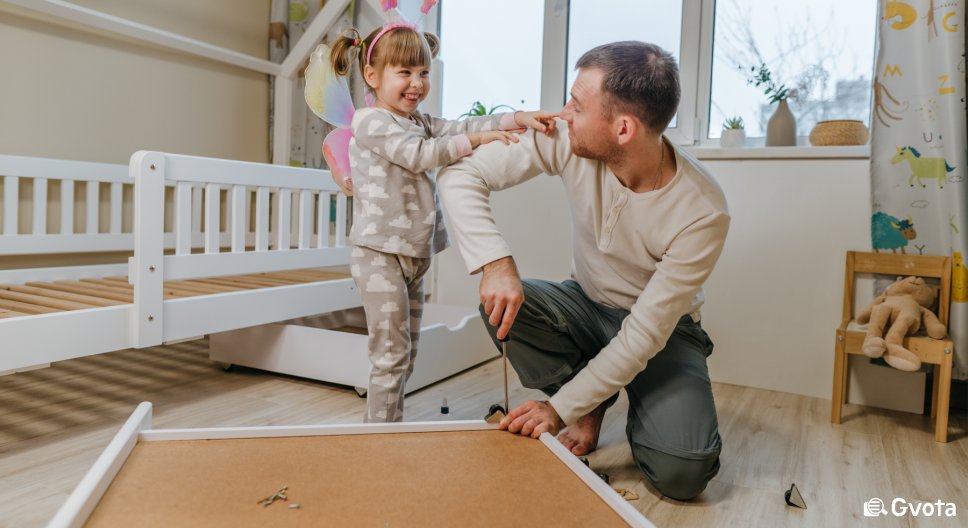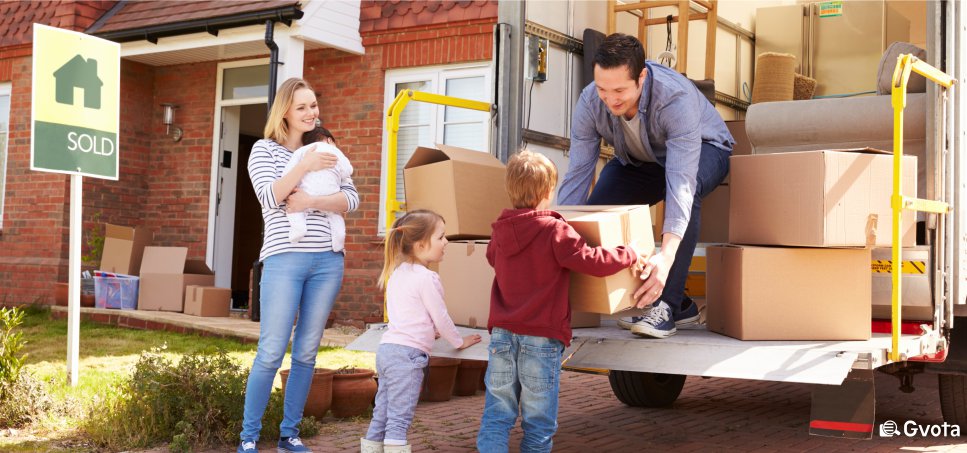Moving with kids to a new location may be perceived as an exciting yet stressful experience for you and your family. It is, indeed, not an easy job to do. Therefore, several factors should be taken into account. This includes choosing the neighborhood, packing, and everything in between the moving stages.
Relocating as a parent can be troublesome because apart from the preparations for the move, it is crucial to ponder the well-being of your kids, especially when you need to talk to them about the relocation.
That said, the experience can be even more daunting for children, as they don’t contribute to the decision to relocate and might not comprehend the purpose of it.
When you uproot your kids from their comfort zone, things get difficult along the moving process. Along with the turmoil of packing boxes, kids are obliged to say goodbye to their friends, teachers, and the ones that are dear to their heart. In such critical situations, your little one needs some time and additional attention.
Follow our tips to have a seamless relocation, help your kids adjust to moving, and even look forward to it.
How to tell a child they are moving
Moving signifies a huge transition for your kids, as they will be exposed to a new environment; therefore, this can cause them to feel anxious. This is a normal response to moving because your children will have to leave their community. Their concern is provoked by the potential changes they will have to face, such as integrating into a new school and making new friends.

Find out how you can help your child to adjust to these changes with our helpful tips:
1. Let your child participate in moving-related discussions
It’s important to sit down and discuss some details with your child. Listen to what they have to say, and make sure to answer all the questions they may have. In addition, this will help them be at ease, and they might have an insight into what to expect. You can also share some of your previous moving experiences, assuring them that everything will be alright.
2. Tell them stories about moving
One of the best ways of easing down your kids’ stress is by encouraging them to read positive books about moving. Tell them stories about the move, and they will see that other people go through the same situation and share the same emotions
This will help them know what to expect, thus giving them a positive perception of the move. They will be able to understand the “why” and “how” of the move through books. Also, they will be able to compare themselves to the heroes of the stories.
Here are a couple of books you can try: The Berenstain Bears’ Moving Day, My Very Exciting, Sorta Scary, Big Move: A Workbook for Children Moving to a New Home, Big Ernie’s New Home: A Story for Young Children Who Are Moving, Tigger’s Moving Day, and Alexander, Who’s Not (Do You Hear Me? I Mean It!) Going to Move.
3. Encourage your kids to help you pack
Have your kids load their own boxes, and they will feel responsible for their goods.
If you have young children, they can play with boxes while packing their belongings. You can teach them how to pack correctly and allow them to take part in the process.

4. Talk to your kids about the move before they notice specific changes
Children tend to easily notice changes during the moving, such as the huge boxes that are placed in each room and the frequent visits to the new home.
As you discuss the relocation with your child, focus on the positive things. Maybe you will be moving to a bigger house, a family-oriented neighborhood, or a town that has a warmer climate.
5. Stay calm while you prepare for a move
Young kids and toddlers are more likely to pick up on their parents’ emotions - especially during anxiety-ridden situations. If you try your best to remain calm while packing and relocating, your kids’ emotions will be positively influenced by your own attitude toward the move.
6. Explore the new neighborhood with your kids
Visit your future housing with your kids, and allow them to familiarize themselves with the new environment. It’s also a good idea to get them acquainted with their potential child care provider. This will help them feel at ease and reduce their fears.

If your kids are older, you can encourage them to research and get acquainted with the new area. Discover sports clubs, parks, and local communities to help your family immerse in the new town.
How to prepare for moving with kids
Before the move, it’s important to find a good moving company to have a stress-free experience, especially when you are relocating with kids. You can request free, unlimited quotes on Gvota and compare prices offered by trustable moving companies in your area.
Remind your child how the day will be
The day before or the morning of the move can seem stressful for your little one. Remind them about the sequence of events that will occur and what to expect.
Prepare a bag containing the essentials for your child
Pack your bags in advance for moving day and for the first evening in the new house. This will make the process much simpler. Some of the essentials to pack for moving day include diapers and hygiene products, medicine, your little one's favorite toys, and clothes.
Arrange your kids’ room first
As you settle in for the first night, try to create a quiet space for your kids. For instance, you can arrange their bed, decorate their room with their favorite toys, so they feel more comfortable. It is preferable to maintain the same furniture and decoration as it was in their previous room. If that isn't possible, tell your little ones that some changes will be made.

Tips for moving with a toddler
Moving with a toddler is easier than relocating with school-aged kids and teenagers; the toddlers’ world is centered around their family, therefore they are limited in comprehending the changes in location. Still, the parent’s role is essential to keep their young ones stable.
- Provide simple explanations to your child about the move. You can recruit their favorite stuffed animal to help you out.
- Describe the move using an appealing story, in addition to trucking toys and furniture.
- Try to give your little one as much attention as you can. Make some time for hugs and snuggles.
- While you pack your toddler’s toys in boxes, explain to them that these aren’t being thrown away.
- If you visit your new home often with your child, move a few toys there each time.
- Call a babysitter to stay with your toddler on moving day.
- Pack your kid’s bedroom last and unpack it first thing after the move.
- If you keep their daily routine as much as possible, your child will be able to adjust to the changes easily.

Things to consider when helping a toddler adjust to moving
It takes time to get comfortable in a new home and neighborhood for both adults and children. Here are a few ways to help your toddler become more stable in the new environment:
- Give them as much attention as you can, even if you are busy loading your boxes. In such cases, all they need is attention. Be sure to listen to their thoughts about the move.
- Consistency is key. Make sure to keep your kids’ routine as consistent as possible. This will make them feel at ease and less anxious about relocating to a new home.
- Plan some fun activities to do with your toddler once everything is settled. Whether it’s going to the playground or finding a group for your child to connect with, this will help your little one realize the positive aspects of the move.
Is moving with kids during their childhood harmful?
Studies show that moving may negatively impact your child’s socio-emotional wellbeing. At all ages, your child will experience an unusual rush of emotions and/or problems. For instance, along with a new relocation come minor declines in social skills, emotional and behavioral issues. In addition, moving to a new home can impede your child’s academic performance at school.
Although the effects are usually small, parents must be aware that they may be extremely sensitive and stressed due to changes in the social environment. Kids can only feel secured and stable through certain factors:
- Parenting
- Family dynamics
- Neighborhood factors
- Impact by peers
- School development
As you sign them up for clubs, join local groups, and meet new people, your child will realize that they are not alone in starting over. Encourage your children to openly articulate their feelings about the move, and be sympathetic toward their concerns. In addition, make sure to not let your own anxiety affect your child’s emotions.

What is the ideal age to move with kids?
Moving with a 6-year-old is far easier than moving with teenagers.
Young kids are less likely to understand the reasons behind the move. Moreover, emotional ties are often not as important, which makes it easier for them to adapt to a new environment.
What is the worst age for moving with kids?
According to experts, moves are hardest for kids that are transitioning to puberty, typically during middle school. This is where a child struggles while changing schools.
Along with moving with kids comes multiple challenges. Your little ones will need time to adjust to the move and comprehend the purpose behind it. Encourage them to always share their thoughts and become active members of their new community. Stay positive, since your children will pick up on your emotions, and frame the relocation as a spontaneous adventure!







